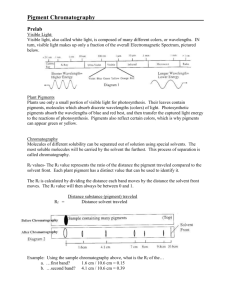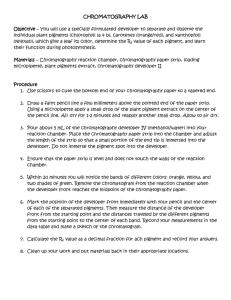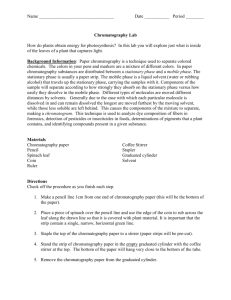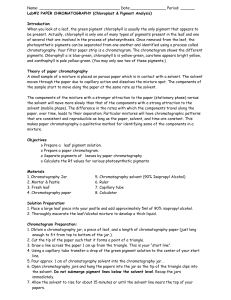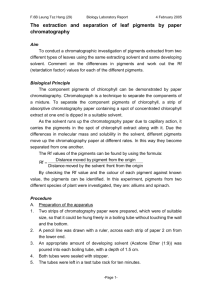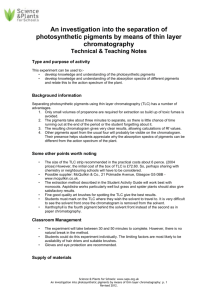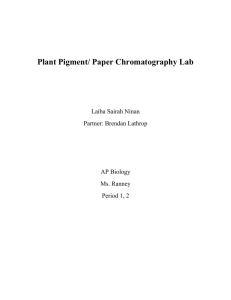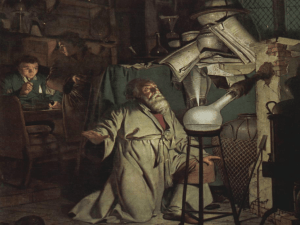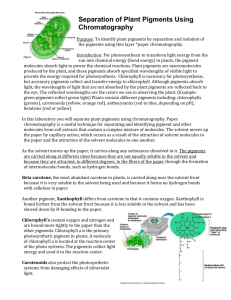Separation of Plant Pigments Using Chromatography Purpose: Why
advertisement
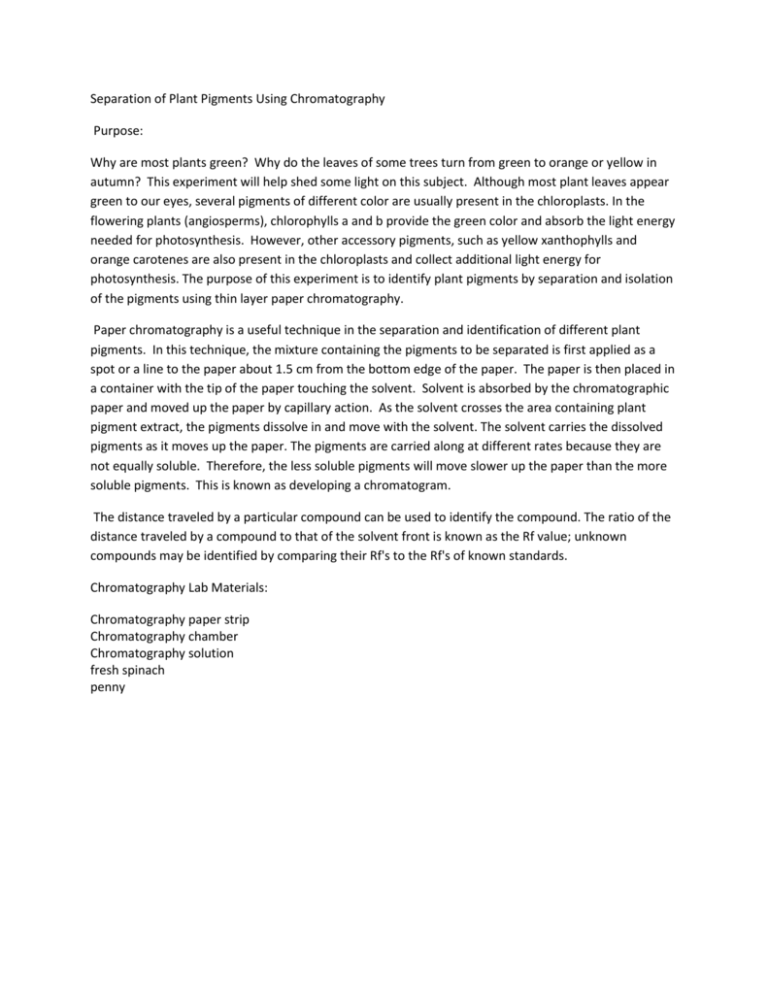
Separation of Plant Pigments Using Chromatography Purpose: Why are most plants green? Why do the leaves of some trees turn from green to orange or yellow in autumn? This experiment will help shed some light on this subject. Although most plant leaves appear green to our eyes, several pigments of different color are usually present in the chloroplasts. In the flowering plants (angiosperms), chlorophylls a and b provide the green color and absorb the light energy needed for photosynthesis. However, other accessory pigments, such as yellow xanthophylls and orange carotenes are also present in the chloroplasts and collect additional light energy for photosynthesis. The purpose of this experiment is to identify plant pigments by separation and isolation of the pigments using thin layer paper chromatography. Paper chromatography is a useful technique in the separation and identification of different plant pigments. In this technique, the mixture containing the pigments to be separated is first applied as a spot or a line to the paper about 1.5 cm from the bottom edge of the paper. The paper is then placed in a container with the tip of the paper touching the solvent. Solvent is absorbed by the chromatographic paper and moved up the paper by capillary action. As the solvent crosses the area containing plant pigment extract, the pigments dissolve in and move with the solvent. The solvent carries the dissolved pigments as it moves up the paper. The pigments are carried along at different rates because they are not equally soluble. Therefore, the less soluble pigments will move slower up the paper than the more soluble pigments. This is known as developing a chromatogram. The distance traveled by a particular compound can be used to identify the compound. The ratio of the distance traveled by a compound to that of the solvent front is known as the Rf value; unknown compounds may be identified by comparing their Rf's to the Rf's of known standards. Chromatography Lab Materials: Chromatography paper strip Chromatography chamber Chromatography solution fresh spinach penny Separation of Plant Pigments Using Chromatography 1. Place the chromatography solution in the chamber and close the lid. 2. Make a pencil mark on the chromatography strip, in the center, directly above the point of the strip, 1.5 cm from the tip of the paper. Using a penny press the spinach pigment into the paper strip until a small dot is saturated with pigment. 3. After you have applied the pigment solution, suspend the paper in the chamber. The tip of the strip should just touch the solvent. Close the lid of the chamber. 4. Wait 15 minutes for the chromatogram to develop. Remove the chromatogram. Be careful to handle the paper on the sides. Results: 1. Mark with a pencil (NOT a pen) where the solvent stopped as it moved up the chromatogram. This is called the solvent front. Also mark in pencil where each pigment stopped moving up the chromatogram. 2. Assign a reference number for each pigment band on the chromatogram. You should see greens, yellow, and yellow-orange. Using a metric ruler, measure the distance each band and the solvent moved from the initial line of pigment and record data in Table 1. Table 1. Distance moved by Pigment Band (in millimeters) Band Number Distance (mm) Distance Solvent Front Moved _________________ Color 3. The relationship of the distance moved by a pigment to the distance moved by the solvent is a constant called Rf . It can be calculated for each of the four pigments using the formula. Rf= distance traveled by the pigment Distance travaled by the solvent Record your Rf values in Table 2. Rf Pigment Carotene Xanthophylls Chlorophyll a Chlorophyll b Conclusion Questions: 1. What reference numbers (Rf) did you calculate for chlorophyll a and chlorophyll b? 2. With what you have discovered about pigments, what conclusions can you make regarding the changing color of leaves in autumn? 3. What adaptive purpose do different colored pigments serve for a plant? 4. Why do some pigments move farther up the chromatogram than others? (think about the marker lab we conducted)
